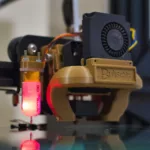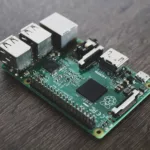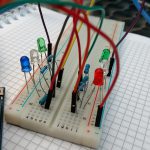
Introduction
In the era of Industry 4.0, integrating robust technology into manufacturing processes has become significant for businesses aiming to stay competitive and efficient. One of the most transformative technologies in this regard is the Internet of Things (IoT)–revolutionising the manufacturing industry by creating smart manufacturing ecosystems. This article examines the use of IoT for smart manufacturing, exploring its benefits, applications, challenges, and future prospects.
Understanding Smart Manufacturing: The Significance and Foundational Aspects
Smart manufacturing, also called Industry 4.0 or the Fourth Industrial Revolution, is a modern or advanced approach to manufacturing that leverages advanced technology and data-driven solutions. Smart manufacturing facilitates improving manufacturing processes’ efficiency, productivity, flexibility, and sustainability. The ultimate goal of smart manufacturing is to create more agile, adaptive, and efficient production processes capable of responding to evolving market demands quickly.
IoT is the backbone of this transformation, which involves embedding sensors, devices, and equipment with connectivity to gather real-time data. It represents a significant shift from traditional manufacturing methods and embraces a more interconnected, automated, intelligent, and optimised approach to production. IoT provides unprecedented benefits to multiple enterprises in various aspects. Some of them are explained below.
IoT in Smart Manufacturing: Exploring the Unparalleled Benefits
IoT is a driving force behind transforming traditional manufacturing processes into smart manufacturing environments. Some practical benefits and examples of IoT used in smart manufacturing include:
- Real-time Data Collection and Monitoring
One of the most significant advantages of IoT in smart manufacturing is to collect and monitor data in real time. Sensors-integrated machines and equipment can track variables like temperature, pressure, humidity, and machine health, enabling manufacturers to gain immediate insights into their production processes’ status. These features also contribute to identifying bottlenecks and making informed decisions to improve overall efficiency and quality.
- Enhanced Quality Control
IoT devices can monitor and enhance the quality of products throughout the manufacturing process. Manufacturers can detect defects or deviations from standards by analysing sensor data in real-time. This ensures marketing of high-quality products by enabling immediate corrective actions and reducing waste.
- Predictive Maintenance
Predictive maintenance is a game-changer for smart manufacturing. With IoT, machinery can continuously transmit data about their performance, allowing algorithms to predict when maintenance is needed before a breakdown. This proactive approach not only reduces downtime but also extends the equipment’s lifespan, leading to significant cost savings.
- Supply Chain Optimisation
Smart manufacturing extends beyond the factory floor and into the supply chain. IoT sensors can track the movement and condition of raw materials, components, and finished products. This visibility optimises inventory management, reduces lead times, and enhances overall supply chain efficiency.
- Energy Efficiency
Sustainability, a growing concern for manufacturers, can be successfully mitigated as IoT significantly reduces energy consumption, benefiting the environment and lowering operational costs. By monitoring and controlling energy usage in real time, companies can identify energy-wasting areas and implement energy-efficient practices.
- Worker Safety
Wearable IoT devices like smart helmets and vests can monitor workers’ vital signs, location, and exposure to hazardous conditions. The real-time data helps ensure worker safety and compliance with safety regulations.
- Human-Machine Collaboration
IoT in smart manufacturing does not replace humans but enhances their capabilities. With IoT-enabled devices and augmented reality, workers can receive real-time instructions, access relevant data, and collaborate with machines more effectively. This human-machine collaboration results in higher productivity and reduced errors.
- Data Analytics and Artificial Intelligence
The vast amount of IoT-generated data is only valuable when properly analysed. Data analytics and artificial intelligence tools can process this data to uncover insights, trends, and patterns–driving continuous improvement in manufacturing processes. From demand forecasting to quality control, AI-powered systems make sense of the data flood.
Challenges and Considerations for IoT in Smart Manufacturing
Incorporating IoT into smart manufacturing offers significant benefits. However, it also presents certain challenges that require crucial considerations. Some of the common challenges with considerations include:
- Cybersecurity Challenges
IoT can introduce cybersecurity challenges due to increased connectivity and create more entry points for potential cyberattacks. Manufacturers must invest in robust cybersecurity measures to protect sensitive data, enhance user experiences, and ensure the operations’ integrity.
- Integration Complexity
Implementing IoT in manufacturing can be complex, especially for businesses with legacy systems. Ensuring seamless integration of IoT devices, sensors, and platforms with existing infrastructure requires careful planning and sometimes significant investments in technology and expertise.
- Scalability and Future Expansion
Scalability is a key consideration when adopting IoT for smart manufacturing. As businesses grow, they must be able to expand their IoT infrastructure to accommodate increasing data volumes and new devices. A well-designed IoT strategy can enable easy scalability and future-proofing.
- Regulatory Compliance
Manufacturers must also navigate regulatory compliance when using IoT in smart manufacturing. Depending on the industry, specific regulations related to data privacy, product quality, and environmental standards need to be met. Additionally, ensuring compliance is essential to avoid legal issues and maintain a positive reputation.
The Future of Smart Manufacturing with IoT
The adoption of IoT in smart manufacturing is expected to bloom in the coming years, driving more sophisticated applications and trends, including:
- 5G and 6G Connectivity: The rollout of 5G and 6G networks will enable incredibly faster and more reliable data transmission, opening the door to new IoT applications and real-time analytics.
- Edge Computing: Edge computing brings data processing closer to the data source, reducing latency and improving real-time decision-making. It comes equipped with unique specifications that serve as an essential component of smart manufacturing.
- AI and Machine Learning: These technologies will become even more integral, driving predictive analytics, autonomous operations, and continuous process improvement.
- Digital Twins: Digital twins, virtual replicas of physical assets or processes, will become more sophisticated. This will allow better simulations, analysis, and optimisation of manufacturing operations.
- IoT Ecosystems: Interoperability between IoT devices and platforms will improve, creating more cohesive and integrated smart manufacturing ecosystems.
Final Thoughts
IoT in smart manufacturing revolutionises facilities by enhancing productivity, efficiency, and overall operations. IoT technology enables manufacturers to collect and analyse real-time data from various aspects of the production process, leading to better decision-making, reduced downtime, and improved product quality. However, cybersecurity, integration complexity, and regulatory compliance challenges must be carefully addressed. With advancements in the technological landscape, the future of smart manufacturing with IoT holds exciting possibilities, making it a trend worth innovation for enterprises and manufacturers seeking competitive markup in the Industry 4.0 landscape.





















